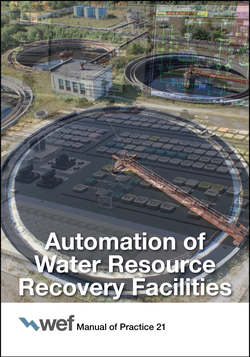Читать книгу Automation of Water Resource Recovery Facilities - Water Environment Federation - Страница 8
List of Tables
Оглавление2.1 Operating costs for a typical WRRF
2.2 Life expectancies of typical control system devices
2.3 Calculation of present worth
3.1 Various design documents and industry standards
3.2 A sample list of monitored variables
3.3 A sample description of an alarm control strategy
3.4 An example of a milestone schedule for a typical control system design for a WRRF
5.1 Sample equipment operating table
7.1 Possible steps in a two-pump station
7.2 Advantages and disadvantages of ANN models
7.3 Types of ANNs and their application areas
8.1 National Electrical Manufacturers Association’s codes for enclosures
8.2 Internal protection digit definition
8.3 National Electrical Code ratings for enclosures
8.4 The ATEX classification
8.5 Typical protocol
8.6 Standards-setting organizations
9.1 Typical flow meter characteristics
9.2 Flow meter applications
9.3 Effect of flow disturbances on the accuracy of transit time flow meters
9.4 Typical weir equations
9.5 Flume flowrates based on size
9.6 Pitot tube piping requirements
9.7 Venturi meter upstream piping requirements
9.8 Level instrument application guidelines
9.9 Level switch application guidelines
9.10 Temperature-measurement application guidelines
9.11 Typical thermocouple materials
9.12 Accuracy and repeatability of temperature-measurement devices
9.13 Treatment processes and the range of solids concentrations that are typically observed
9.14 Typical construction materials for ISBL analyzers
11.1 An example of how to decide between copper and fiber installations
11.2 Key differences between the types of cloud systems
12.1 Human threat-source, motivation, and threat actions
12.2 Possible ICS vulnerability assessment actions
12.3 Likelihood definitions
12.4 Risk-level matrix
12.5 The ISA-99 series of industrial automation and control systems security standards
12.6 The NERC-CIP standards
13.1 Eight “challenges” of situational awareness
13.2 Alarm management life cycle shows alarm life-cycle stages, as well as the applicable clauses within the standard
13.3 Alarm performance metric summary
14.1 Process controller selection criteria
14.2 Examples of control function blocks
15.1 Original data with calculated precision and accuracy values
16.1 Sample training plan for instrumentation technicians
16.2 Sample skills growth plan
16.3 Mentoring form
